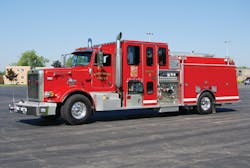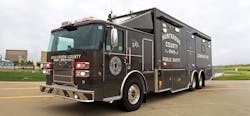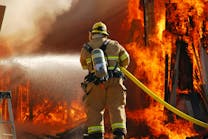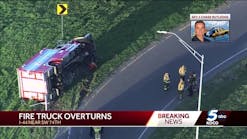For many years fire apparatus were traditionally built on commercial chassis as they were readily available and could easily be adapted for different fire service applications. During World War II, with all manufacturing efforts designated to provide materials for our troops, very few municipal fire departments were able to acquire any type of new apparatus. Notable manufacturers like Maxim, Mack and Hahn together with both American and Ward La France turned out hundreds of fire apparatus built on commercial chassis to support the war efforts here at home and overseas. It was not until late in 1945 when American La France introduced their cab ahead of engine design with the 700 series model apparatus that fire departments began to acquire this style of custom cab apparatus, replacing conventional engine ahead units.
In several parts of our country where colder winter weather prevails many departments continue to prefer the conventional engine ahead design which allows the apparatus manufacturer to construct their own crew cab and body compartments on the chassis. Heavy duty International, Kenworth and Peterbilt chassis are often favored as they can provide a wide range of engine and chassis options to meet the needs of these departments at considerable cost savings over a full custom fire chassis.
The North Bailey Fire Department operates as one of several all volunteer organizations in the Town of Amherst, NY, which lies just north of Buffalo. The department today is under the command of Chief Dave Humbert and covers a 2.2-square-mile area of the township which is heavily built up with commercial strip malls, plazas, schools as well single-family homes. The department has a long history of operating with heavy duty commercial chassis for their apparatus including a 1974 Ford LS model 1,250-gpm pumper with Young bodywork and a 1980 Ford LS 1,250-gpm pumper built by Pierce which is assigned as Engine 2. While these pumpers had a longer wheelbase than a custom chassis unit, the setback front axle provided a reasonable turning radius for the apparatus.
The Department Today
The current fleet of North Bailey apparatus operates from a single station and consists of a 1993 Peterbilt model 377 chassis with bodywork by Custom Fire. Engine 3 is equipped with a 1,750-gpm pump with a 750-gallon water tank. Rescue 5 is a 1999 Peterbilt model 330 which is equipped with a walk-in crew area at the front of the body together with a fully compartmented rescue body which was also built by Custom Fire. The department operates a unique tractor drawn aerial ladder with an American La France 100-foot trailer that originally saw service with the Buffalo Fire Department. The tractor for Ladder 6 is a 1974 Ford L-800 model which was modified to accept the trailer. In addition the department operates an EMS first response unit and several chiefs vehicles.
When the department sought out to replace Engine 2 they carefully studied their response area and the types of equipment that would normally be utilized at an incident. After meeting several times with the department's apparatus committee they began to work closely with Mike McLaughlin from Empire Emergency Apparatus who represents Rosenbauer America.
The result of this planning was the delivery of a 2009 Rosenbauer General pumper built on a Peterbilt model 367 chassis. The 367 model chassis was built with a 10 3/4-inch frame with a full length liner incorporating a 20,000 pound rated front with a 30,000 pound rated rear axle. The unit is powered by a Caterpillar model C-15 engine rated at 435 horsepower through an Allison Generation IV model EVS-4000 five-speed automatic transmission. The apparatus is equipped with 16 1/2-inch by 7-inch brakes on both the front and rear axles together with a Caterpillar compression engine brake utilized for auxiliary braking. The Peterbilt cab was built with seating for two personnel with a bumper to back of cab dimension of 123 inches.
The pumper is built with a wheelbase of 258 inches and an overall length of 35 feet, seven inches. Rosenbauer constructed a full height aluminum crew cab which provides seating for six personnel and all seats are equipped with hands-free SCBA brackets and hand tools mounted in PAC brackets for the protection of the crew. The crew cab area had dimensions of 92 inches wide and 96 inches high with 76 inches of headroom area. Each side of the crew area can be accessed through a vertically hinged door which is approximately 28 inches wide. Both the front cab and crew area are provided with climate control for heating and air conditioning.
Bumper And Lighting Setup
The front bumper was extended 18 inches and is equipped with a 2 1/2-inch front discharge that carries 100 feet of 1 3/4-inch attack line and a short length of five-inch hose in an aluminum tray. A four-inch front suction extends through the front bumper on the right side with bumper guides provided at each corner.
The apparatus warning light package consists of a two recess mounted Code 3 LED light bars 92 inches wide located at the front and rear of the crew cab enclosure. Code 3 model 550 halogen rotating lights were mounted at the upper rear of the body. Other warning lights consist of Whelen model 600 LED lights at the front grill and along the front sides and rear of the apparatus cab and body. A Code 3 LED arrow stick light bar is recessed mounted at the rear of the body below the hose bed.
A 10-Kw Smart Power hydraulic generator provides power for an electric cable reel equipped with 200 feet of 10/4 cable and scene lighting. Two Fire Research 1,000-watt Focus lights are located above the body on each side with the poles nested within the body compartments. Two non-telescopic Fire Research Focus 1,000-watt lights are mounted above the body compartments on each side of the body.
Pump And Body Features
The body is fabricated from 5052-H32 aluminum and is provided with seven enclosed body compartments with hinged aluminum doors. The compartments are well organized and laid out using an assortment of slide trays and adjustable shelves with Performance Advantage Company PacTrac and brackets utilized to secure adapters, fittings and hand tools. The rear body compartment is equipped with an electric cable reel, hydraulic hose reel, power unit, cutter and smoke ejectors mounted on a slide tray.
Ground ladders are carried on a hydraulic ladder rack on the right side of the body with a 28-foot two section extension, 14-foot roof and a 10-foot folding ladder. The rear hose bed is equipped with two beds each with 550 feet of four-inch hose, 500 feet of 2 1/2-inch hose and 500 feet of 1 3/4-inch hose. The rear hose bed is protected by lift up hinged aluminum tread plate covers. The hose bed area can be accessed using fixed steps that are provided at the rear body on each side. A unique arrangement is provided for three speedlay attack lines that are located under the crew cab compartment and are equipped with two 200-foot 1 3/4-inch and one 250-foot two-inch pre-connected attack lines.
The fire pump on Engine 2 is a Waterous model CSUY single-stage pump rated at 1,750 gpm which can supply any one of the four attack lines and the four pump panel discharges in addition to 3 1/2-inch discharge supplying a Task Force Monsoon electric deck gun. The fire pump intakes consist of two six-inch inlets each equipped with air operated valves with a 2 1/2-inch auxiliary intake on each side panel. The left side pump panel is provided with two 2 1/2-inch discharges with one 2 1/2-inch and one 3 1/2-inch discharge located at the right side panel. An additional 2 1/2-inch and 3 1/2-inch rear discharge are provided at the rear body. A Foam Pro 2001 Class A foam system can supply any one of the four pre-connected attack lines with a 30 gallon tank. The engine is equipped with a 750-gallon water tank with power refill capabilities for the foam tank. All pump discharges are equipped with Waterous electric power operated valves with position indicators.
The right side pump panel is provided with lift and turn fasteners to allow for quick access into to the fire pump for service and maintenance. Recessed hose wells with aluminum tread plate covers are provided on each side of the apparatus with standpipe packs carried in these compartments. A small booster reel is provided above the fire pump on the right side of the unit.
With a combination of the commercial Peterbilt 367 cab and chassis and the Rosenbauer General fire body the North Bailey Fire Department's new Engine 2 is an excellent example of a well developed piece of apparatus. I would like to thank Chief Dave Humbert and Mike McLauglin who assisted with technical information on this apparatus.
TOM SHAND is a 37-year veteran of the fire service having served with departments in Maryland, Pennsylvania and New York. He has worked in the fire apparatus industry since 1985, including 15 years with Saulsbury Fire Apparatus. He is a contributing editor to Fire Apparatus Journal and Firehouse Magazine and works with Mike Wilbur at Emergency Vehicle Response. He co-hosts the Apparatus Architects podcast with Wilbur, based on their column in Firehouse Magazine.






